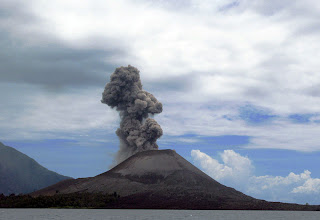Volcanic eruption is one of the natural disasters that have been killing human beings for thousands of years. In the past, predicting volcanic eruption is difficult because of the lack of advance tools and technology to use. Today, with the availability of tools and resources, it is easier to predict the behavior of volcanoes - when will they erupt and who will be affected. Many lives are saved due to these tools. Unfortunately, in the past, many lives were lost because of the absence of tools to measure and predict volcanic activity. Here are some of the historic volcanic eruptions with the highest death tolls in no particular order.
1. Mt. Tambora Eruption – Indonesia (1816)
The Mount Tambora eruption that happened on April 10-15, 1816 took away the lives of an estimated 92,000 people which included 10,000 deaths due to the explosion and ash fall, and about 82,000 from other causes related to the volcanic eruption. The 13,000 feet tall volcano was reduced to 9,000 feet after the explosion. The explosion ejected 93 cubic miles of debris into the atmosphere. Effects were felt worldwide. Gross climatic changes, a mini tsunami, volcanic ash rain and the destruction of crops and livestock caused an additional death toll of 100,000 people. Smaller eruptions have indicated that Mt. Tambora is still an active volcano.
2. Mt. Pelee Eruption – West Indies (1902)
What was believed to be a dormant volcano, Mt. Pelee started its volcanic activities in the early 1902. The primary eruption happened on May 8, 1902 which completely destroyed the city of St. Pierre. The eruption killed about 25,000 to 40,000 people and the only survivors were a man who was in a prison and a man who lived on the outskirts of town. The once large and prosperous city was covered in volcanic ash after the eruption. Additional casualties were also listed after the eruption. Destructive mudflow and sheer heat because of the smoke from the volcano claimed more than 30,000 lives.
3. Mt. Krakatoa Eruption – Indonesia (1883)
The volcanic eruption of Mt. Krakatau on August, 1883 ejected more than six cubic miles of debris into the atmosphere and left 75% of the island in total ruin. The eruption was documented as the loudest ever explosion which was also heard in places as far as Australia and Mauritius. The Krakatau explosion also disrupted vessels floating on the South African coast. There were no casualties in the initial explosion but the resulting tsunami took away 36,000 lives. Pyroclastic flows destroyed places in Java which were never repopulated. The island Anak Krakatau came into existence years after the explosion.
4. Nevado Del Ruiz Volcano Eruption – Colombia (1985)
After 150 years of being inactive, the Nevado Del Ruiz volcano erupted in 1985 with a total death toll of 23,000. Deaths from the eruption were attributed to the massive mudslides. The small eruption melted the volcano’s ice cap caused massive mudslides that buried the city of Armero. Magma that came out of the eruptions was found to have high levels of sulfur dioxide. The threat of future eruptions looms large upon Manizales which is very close to the fatal volcano.
5. Mt. Unzen Eruption– Japan (1792)
The Mt. Unzen eruption occurred along the very active Pacific Rim of Fire. The eruption was followed by other cataclysmic events like an earthquake, avalanche and a tsunami. The eastern part of the volcano’s dome collapsed resulting into and avalanche. The avalanche created the tsunami that killed 12,000 to 15,000 people in nearby towns. The 1792 eruption was coupled with deadly dacitic lava flow from the Fugen-dake peak.
6. Mt. Vesuvius Eruption– Italy (AD 79)
The eruption of Mt. Vesuvius completely destroyed the Roman towns of Pompeii and Herculaneum. The 19-hour volcanic eruption buried Pompeii in ten feet of volcanic ash. The eruption was considered as one of the most famous eruptions of all time. The AD 79 eruption of Vesuvius had a reported death toll of 10,000. Intense heat carbonized organic materials in the area. Victims were found without the top of their heads as their brains were reportedly boiled and exploded. The outbreak was ordained by various signs on the surface of the earth that the Romans failed to read.
7. The Laki Volcanic System Eruption – Iceland
Laki or what is popularly known as ‘Craters of Laki’, is a system of Eldgja canyon and Katla volcano. The 1783 to 1784 eruptions created a volcanic haze that created massive food shortages. There were 9,350 deaths which are mostly due to the widespread starvation. The sulfur-dioxide fumes that came out the crater ravaged the livestock. There were also wild weather changes like drought, hailstorms and bitter winters. These events occurred all over the Northern Hemisphere over the years that followed the eruption.
8. Mt. Vesuvius Eruption– Italy (1631)
Mt. Vesuvius of Italy made the top ten for the second time with its eruption in December 1631 which killed as many as 6,000 people. The notorious volcano has erupted more than a dozen times since it destroyed Pompeii and Herculaneum in AD 79 but the more destructive eruption happened in 1631. The 1631 eruption was destructive because of the boiling water that accompanied the hot lava ejected from the volcano.
9. Mt. Kelut Eruption – Indonesia
Indonesia has been a victim of major volcanic eruptions. The Mt. kelut eruption on May 19, 1919 took away 5,110 lives. Mudslides happened during the eruption and most of the deaths were apparently due to these mudslides. The ampere tunnel was created in the crater to empty the Crater Lake and reduce the risk of mudflows. Recently in 2007, Mt. Kelut
10. Mt. Galunggung Eruption – Java, Indonesia
Another deadly volcano in Indonesia, Mt. Galunggung erupted in the year 1882 with a death toll of 4,011. The Ten Thousand Hills in Tasik, Malaja was reportedly formed from the accumulated deposits of lava that leaked from Galunggung volcano according to western geologist but others propose that it was created artificially. The ever- active nature and horseshoe shape of Galunggung Volcano indicates how active the volcano is which dates back up to 23,000 years ago.
Honorable mentions: Papandayan Volcano in Java Indonesia which destroyed villages and killed 3,000 villagers in 1772. Mount Lamington in Papua New Guinea had around 3,000 deaths in total due to fumes and magma showers.











No comments:
Post a Comment